|
|
Shakespeare's Sources for Troilus and Cressida
From Troilus and Cressida. Ed. William J. Rolfe. New York: American Book Co.
If Shakespeare did not draw his materials from some earlier play, he probably took "the love-story" from Chaucer's Troilus and Cresseide, and "the camp story" from the Recuyell of the historyes of Troye, translated and drawen out of
frenshe into englishe by W. Caxton, 1471 (from Raoul le Fevre's Recueil des Histoires de Troyes), or Lydgate's Hystorye, Sege
and dystruccyon of Troye, 1513, 1555 (from Guido di Colonna),
or both. Thersites, or at least a hint of the character, seems
to be taken from Chapman's Iliad, the first seven books of
which appeared in 1597.
Ward (Dramatic Lit, i. 433) remarks: "Though the story
of Troy has continued to furnish poetic literature — and especially that of the drama — with themes, I am not aware that
any other hand has followed Shakespeare's in reproducing the episode, mediaeval rather than antique in its essence, of Troilus and Cressida.
How to cite this article:
Shakespeare, William. Troilus and Cressida. Ed. William J. Rolfe. New York: American Book Company, 1892. Shakespeare Online. < http://www.shakespeare-online.com/sources/troilussources.html >.
____
Related Articles
 Troilus and Cressida: The Complete Play Troilus and Cressida: The Complete Play
 Shakespeare's Wisest Play: Exploring the Virtues of Troilus and Cressida Shakespeare's Wisest Play: Exploring the Virtues of Troilus and Cressida
 Introduction to the Character of Cressida Introduction to the Character of Cressida
 Shakespeare's Impact on Other Writers Shakespeare's Impact on Other Writers
 Why Study Shakespeare? Why Study Shakespeare?
 Quotations About William Shakespeare Quotations About William Shakespeare
 Why Shakespeare is so Important Why Shakespeare is so Important
 Shakespeare's Reputation in Elizabethan England Shakespeare's Reputation in Elizabethan England
 Shakespeare's Boss: The Master of Revels Shakespeare's Boss: The Master of Revels
 Shakespeare's Language Shakespeare's Language
 Words Shakespeare Invented Words Shakespeare Invented
 Play Chronology Play Chronology
 Shakespeare Characters A to Z Shakespeare Characters A to Z
 A Shakespeare Glossary A Shakespeare Glossary
|

|
|
